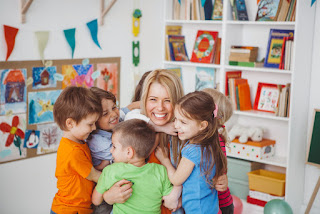Your preschool furniture AUS and supplies come together to
create an environment that is tailored to meet the needs of young preschoolers.
Some caregivers make the mistake of expecting an toddler to fit into an
adult-sized space that has undergone only a few modifications. Preschoolers are
naturally curious and are motivated to use all of their senses to explore their
environments, whether these environments are child-friendly or not. While the
initial set-up of an adult-sized facility may be easier, the actual day-to-day
interactions between the teacher, the child, and the environment will be filled
with chaos. Adult-sized chairs around the room become instant climbing units
for toddlers, and books not specifically created for infants become teething
rings and possible choking hazards. By child-sizing your toddler room, you will
not only create a safe, welcoming environment for the children in your care,
but you will spend far less time lifting and redirecting children, bending over
and picking up knocked over items, and reaching for toys and books on high
shelves. The learning environment needs to cater for different learning styles
and capabilities. Welcoming spaces that reflect and enhance the lives of
children and families participating in the center are crucial for learning
growth. Learning environments must be responsive and enabling to the needs of
children as well as to the intention of the educators. Environments such as preschool furniture AUS must support children to explore using all their senses and
develop dispositions for learning such as curiosity, cooperation, confidence,
creativity, persistence and imagination. Indoor and outdoor spaces must be
flexible and responsive to the interests and rights of individual children and
this includes access to quiet spaces for thinking and wondering and more active
spaces for sharing, laughing, building, climbing, digging, gardening, creating,
dancing and being active. There needs to` be opportunity for children to make
choices and develop autonomy and independence, being encouraged and supported
to make more complex decisions and follow through on their interests and ideas.
The indoor and outdoor learning environment must provide a range of spaces and
opportunities for active exploration through play and the investigation of
meaningful ideas including investigation with a range of technological
resources and being able to problem solve, inquire, experiment, hypothesis,
research and investigate. Children need a range of spaces to be able to fully engage
in all forms of arts. Educators need quiet and private spaces to meet, discuss,
reflect and plan for children’s learning.
Preschool furniture setup is pivotal in the success and
effectiveness of any childcare facility, whether it’s a non-residential
preschool care or a home preschool center. Creating your preschool care layout
is more than playful decorations and lots of toys. A well-designed preschool
furniture and setup involves strategy and planning to craft the perfect
environment for learning and development. From choosing child-safe preschool
furniture to decorating ideas to room layout, we must know the do’s and don’ts
of designing your preschool setup.

Comments
Post a Comment